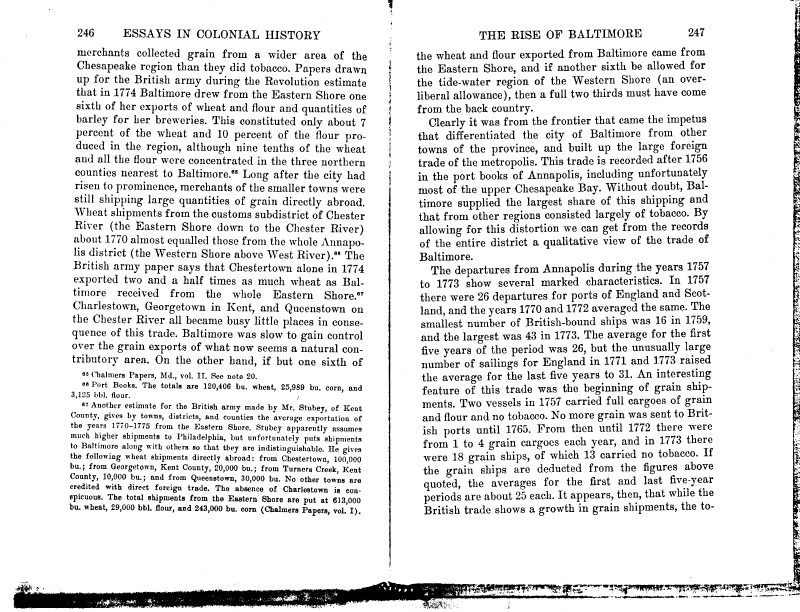|
246
ESSAYS IN COLONIAL HISTORY
THE RISE OF BALTIMORE
247
merchants collected grain from a wider area of the
Chesapeake region than they did tobacco. Papers drawn
up for the British army during the Revolution estimate
that in 1774 Baltimore drew from the Eastern Shore one
sixth of her exports of wheat and flour and quantities of
barley for her breweries. This constituted only about 7
percent of the wheat and 10 percent of the flour pro-
duced in the region, although nine tenths of the wheat
and all the flour were concentrated in the three northern
counties nearest to Baltimore.85 Long after the city had
risen to prominence, merchants of the smaller towns were
still shipping large quantities of grain directly abroad.
Wheat shipments from the customs subdistrict of Chester
River (the Eastern Shore down to the Chester River)
about 1770 almost equalled those from the whole Annapo-
lis district (the Western Shore above West River).66 The
British army paper says that Chestertown alone in 1774
exported two and a half times as much wheat as Bal-
timore received from the whole Eastern Shore.67
Charlestown, Georgetown in Kent, and Queenstown on
the Chester River all became busy little places in conse-
quence of this trade. Baltimore was slow to gain control
over the grain exports of what now seems a natural con-
tributory area. On the other hand, if but one sixth of
«» Chalmers Papers, Md., vol. II. See note 20.
«« Port Books. The totals are 120,406 bu. wheat, 25,989 bu. corn, and
3,125 bbl. flour.
•T Another estimate for the British army made by Mr. Stubey, of Kent
County, gives by towns, districts, and counties the average exportation of
the years 1770-1775 from the Eastern Shore. Stubey apparently assumes
much higher shipments to Philadelphia, but unfortunately puts shipments
to Baltimore along with others so that they are indistinguishable. He gives
the following wheat shipments directly abroad: from Chestertown, 100,000
bu.; from Georgetown, Kent County, 20,000 bu.; from Turners Creek, Kent
County, 10,000 bu.; and from Queenstown, 30,000 bu. No other towns are
credited with direct foreign trade. The absence of Charlestown is con-
spicuous. The total shipments from the Eastern Shore are put at 613,000
bu. wheat, 29,000 bbl. flour, and 243,000 bu. corn (Chalmers Papers, vol. I).
the wheat and flour exported from Baltimore came from
the Eastern Shore, and if another sixth be allowed for
the tide-water region of the Western Shore (an over-
liberal allowance), then a full two thirds must have come
from the back country.
Clearly it was from the frontier that came the impetus
that differentiated the city of Baltimore from other
towns of the province, and built up the large foreign
trade of the metropolis. This trade is recorded after 1756
in the port books of Annapolis, including unfortunately
most of the upper Chesapeake Bay. Without doubt, Bal-
timore supplied the largest share of this shipping and
that from other regions consisted largely of tobacco. By
allowing for this distortion we can get from the records
of the entire district a qualitative view of the trade of
Baltimore.
The departures from Annapolis during the years 1757
to 1773 show several marked characteristics. In 1757
there were 26 departures for ports of England and Scot-
land, and the years 1770 and 1772 averaged the same. The
smallest number of British-bound ships was 16 in 1759,
and the largest was 43 in 1773. The average for the first
five years of the period was 26, but the unusually large
number of sailings for England in 1771 and 1773 raised
the average for the last five years to 31. An interesting
feature of this trade was the beginning of grain ship-
ments. Two vessels in 1757 carried full cargoes of grain
and flour and no tobacco. No more grain was sent to Brit-
ish ports until 1765. From then until 1772 there were
from 1 to 4 grain cargoes each year, and in 1773 there
were 18 grain ships, of which 13 carried no tobacco. If
the grain ships are deducted from the figures above
quoted, the averages for the first and last five-year
periods are about 25 each. It appears, then, that while the
British trade shows a growth in grain shipments, the to-
|

